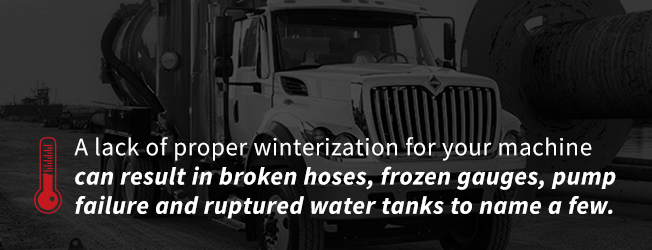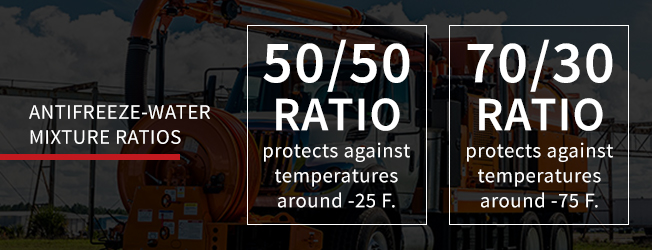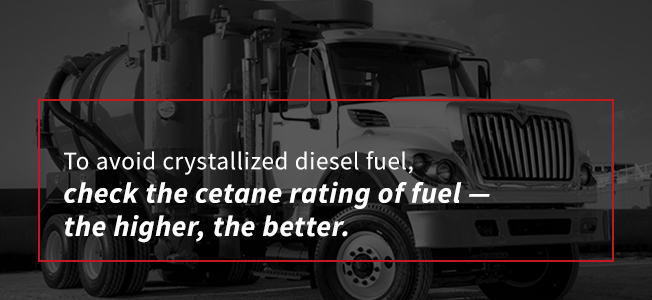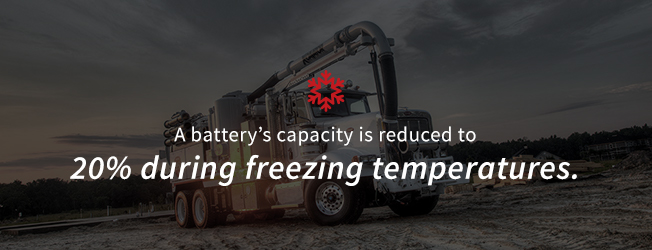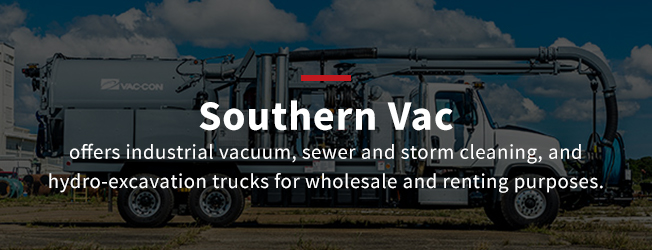It’s no secret that driving – much less working – in the winter can prove harmful to any machine. Harsh conditions and freezing temperatures may vary by your location, but winterizing your combination or vacuum truck will extend its life. Maintaining your vehicle throughout the cold season will not only preserve its life and efficiency, but also save you from high repair costs.
Cold temperatures make it harder for engines to work properly, snow and ice can limit tire traction, and salt can cause rust. A lack of proper winterization for your machine can result in broken hoses, frozen gauges, pump failure and ruptured water tanks to name a few negative outcomes. Repairing one or several of these items on your truck can cost hundreds, if not thousands, of dollars.
If you are looking to winterize your combination or vacuum truck, take a look at the following guide.
1. Prepping the Water Tank
Regularly maintaining the water tank in your combo or vacuum truck is necessary year-round, not just during the winter. If you aren’t currently using the water tank, leave it empty. It’s one of the easiest steps you can take to winterize your vacuum truck.
Draining
It might seem easiest just to leave water in the tank until next time. After all, why empty it only to fill it again later? But the reality is that there are many important reasons to drain your water tank when it’s not in use. A few of these reasons include:
- If the inlet filters or gaskets are damaged, materials can enter the water tank. Debris has potential to damage the rodder pump seals or clog the oil cooler.
- Materials can also enter the water tank through the air vents. Contaminants from weather conditions such as snow, high winds and rain can damage the water system.
- If you fill the water tank with an unfiltered source, rather than using a hydrant fill system, chemical and bacterial contamination may become a problem.
Periodically draining the water tank of your machine can extend the life of its water system by removing foreign materials and chemicals. Although dirt and debris may not seem like detrimental elements for large machines, the accumulation can cause severe wear and tear within the water tank.
Avoiding Ice Damage
Winterizing the water tank in your machine prevents freezing in the pumps, lines and other components. It’s important to drain all plugs and valves to rid the tank of excess water that can freeze. To avoid ice damage in your water tank, follow these helpful steps.
- Verify the flow of water when the system is open to ensure that ice hasn’t clogged up drain lines, plugs or valves.
- Leave all drain plugs and valves exposed, allowing residual water to drain.
- Never operate your combination or vacuum truck if the water pump system freezes.
Winterizing
To properly winterize your water tank system, the following method will offer you some generalized tips.
- Move your vehicle to a suitable draining area.
- Remove the clamp, cap and gasket from the Y-strainer.
- Open the water tank and heat exchanger drains. Leave all valves open to rid the tank of residual water.
- Remove the quick disconnects from the handgun hose reel.
- Start the truck’s engine and leave it on idle.
- Engage the hydraulic pump, close the rodder ball valve and open the handgun valve.
- Run the rodder pump until water expels from the handgun system. Then, turn off the rodder pump.
- Remove the water pump drain plugs and run until all pump water expels. Again, turn off the rodder pump.
- Tightly secure the rodder hose and leave all valves open.
- To remove water from the hose, rotate the reel clockwise.
- Switch the rodder valve and handgun to the “on” position.
- Remove the drain and manifold plugs. Operate rodder pump until all the water drains.
- Disengage the hydraulic pump and remove the plug near the rear tire. Open the valves and remove any debris.
After draining is complete, leave all valves and drains open, and allow your machine to sit overnight.
2. Checking the Fluids
Your vacuum truck is full of different kinds of fluids including fuel, antifreeze, oil and more. When it comes to winterizing your truck, it’s important to check in on all these fluids and make sure they’re ready to ride out the winter comfortably.
Coolants and Antifreeze
Vehicles typically require a 50/50 antifreeze-water mixture for proper cooling, but in some situations — like freezing temperatures — you may need higher ratios of antifreeze. Antifreeze maintains the radiator and engine in your machine and protects these components from freezing.
The typical 50/50 ratio can provide protection for temperatures around -25 F. If your truck requires an increased antifreeze to water ratio for harsher winter conditions, a 70/30 proportion can deliver protection for temperatures reaching -75 F. To find out more about different forms of coolant and water ratios, most antifreeze manufacturers provide charts on the back of their products.
Ideally, if a freeze plug in your engine freezes, you will have a leaking coolant system. Engines have several freeze plugs designed to rupture if internal fluid freezes. However, if the liquid in the cooling system freezes, it can cause damage to the point where you will need to replace your engine block. Making sure you have the correct coolants is an essential step in winterizing your combo or vacuum truck radiator and engine.
You may also want to consider flushing your coolant system to remove sediment and other foreign materials. Sediment can reduce the coolant’s efficiency, and debris mixed with a coolant can cause serious issues.
When extreme weather enters the equation of your truck’s engine and coolant systems, inspect the core and end tanks for any leaks. If you have a plastic end tank on your radiator, it will be more susceptible to cracking and splitting after years of use and exposure to temperature variations.
Oil
The viscosity of oil relates to how fast or slow it flows throughout your combination or vacuum truck system. The higher the viscosity, the slower the flow. Because you don’t use the same oil in the winter as you use for summer, be sure to research which type is best for each season. By switching to a more winter-friendly oil, you can reduce the wear and tear on your truck’s starter, injection system and battery. The correct viscosity of oil will protect your machine in cold startup environments.
If your oil becomes too cold, its thickening properties can potentially force greater resistance on the engine system, and it will have difficulty lubricating proper elements. The higher viscosity of the oil also raises the system’s pressure.
Check your owner’s manual for the correct types of oil, since it varies depending on the type of combination or vacuum truck. If your truck experiences extreme climates, 0W-40 is the recommended oil. During the winter, always use hydraulic oil and lubricants designed for cold weather.
Fuel
Fuel is often overlooked as a risk factor when the winter season rolls around. Similar to oil, diesel fuel has paraffins, causing it to thicken or crystalize when temperatures become cold. The gel-like diesel fuel can clog fuel injectors and make it hard to start your machine. To avoid crystallized diesel fuel, check the cetane rating of fuel — the higher, the better.
It’s also common for distributors to mix a “winter blend” containing 2D and 1D fuel. To winterize the fuel in your combination or vacuum truck, you can also fill your diesel tank with additives such as cold-weather and anti-gel substances, but be sure to check your manual beforehand. Whether you choose to use mixed fuel or additives during the winter, either option will increase your truck’s performance and ensure a smooth flow of fuel.
Examining Major Components
With winter around the corner, it’s always a good idea to give a little extra attention to the major components of your truck. Neglecting these components could lead to some serious problems when the winter snows begin to pile up. With that in mind, here are a few of the major components to focus on.
Filters
Your combination or vacuum truck most likely runs on diesel fuel. This fuel contains paraffins that cause the fuel to gel when temperatures drop below freezing. This gelling can clog your truck’s fuel filter and lines, resulting in the engine not starting. To winterizing your filters, replacing dirty filters with clean units and using a winter additive for protection. You can also treat your tanks with additives to prevent water and gel buildup.
Tires
Inspecting your tires for any cuts, gashes or damage is a good place to start when winterizing your truck. Any failures in the tires may require a replacement to avoid blowouts or air leaks. Once you’ve inspected your tires for damage, check the tread depth. The tread depth of the tires will determine whether they can survive winter conditions well enough to uphold appropriate grip features. Low tread depth will increase your risk of hydroplaning in the snow.
If you are expecting a severe winter, switching to snow or ice tires can be beneficial. The recommended tread depth for snow tires is 6/32” — ensuring the snow compresses and releases as each tire rolls. During the cold winter months, it’s also helpful to add chains to your tires and check for appropriate air pressure.
Battery
According to Mishimoto Engineering, a battery’s capacity is reduced to 20% during freezing temperatures. The colder the battery gets, the slower the chemical reaction to start your engine. An unreliable battery can leave you stranded as temperatures begin to drop. You will want to either replace your truck’s battery or have it tested before the cold weather sets in.
Because a cold battery is less powerful than a warm one, investing in a battery heater may be beneficial. A battery heater slides over the battery and uses an external electrical source. A battery sleeve such as this will reduce your truck’s chance of not starting, and will keep it at an optimal operating status.
Plugs
Other than battery issues, faulty glow plugs are one of the main reasons for engine failure startup. The purpose of a glow plug is to heat the combustion chamber for cold startups. Essentially, it kick-starts your engine. Many modern glow plug systems remain active for a short period to improve cold weather emissions. Although a glow plug can fail as a result of many factors, it will be more likely to fail as temperatures drop.
Ball Valves
Nothing is more frustrating at the beginning of the day your ball valve freezing shut. No matter how hard you push and pull, the valves simply won’t budge. In this case, it may be beneficial to purchase heated valves. The valves connect to the electrical system in your combo or vacuum truck.
Brakes
The combination of salt and brakes rarely lead to positive outcomes. Brakes become more susceptible to corrosion and rusting when salt and other chemicals are thrown on roadways to prevent icing. The corrosive chemicals can seep in between the brake pads and shoe table, pushing the units apart over time.
When this happens, these mechanisms weaken and potentially lock up your brakes. When temperatures reach below freezing, the combination of salt and brakes becomes even worse. One way to avoid corrosion and potentially inoperable brakes is to clean your vehicle regularly for winterization upkeep.
Belts, Gaskets and Hoses
A visual inspection of your vehicle’s belts and gaskets for cracks and tears will determine whether you need replacements.
Hoses, such as radiator and intercooler, can become a major issue when winter arrives. You’ll want to check for cracks in the rubber and address any leaks by replacing the hose. The texture should be spongy and return to its original shape when squeezed. If you’re in doubt about whether any of your belts, gaskets or hoses are up to facing another winter, it’s best to replace them.
3. Cleaning Your Combination or Vacuum Truck
While the internal elements of a truck are important to winterize, so is the outside of your combo or vacuum machine. Especially during the winter, salt on the roadways can be detrimental to your truck. Although salt is necessary for the safety of all drivers, it can also corrode the metal surfaces of your vehicle. An underside coating may be a positive feature, but a damaged coating can leave your truck susceptible to salt and rust.
To avoid rusting on the underside and other areas of your machine, clean the truck thoroughly after snow storms and regularly throughout the winter.
4. Upgrading
You can improve the reliability of your combo or vacuum truck in cold weather by installing a few upgrades. A battery heater can help a battery perform more efficiently in severe weather. Similarly, an engine block heater keeps the engine and coolants warm overnight and helps them to be more reliable during the cold winter months. A warm engine makes for easy startup and reduces fuel consumption related to cold starts.
Another upgrade you may consider for your machine is a grille cover. It blocks air flow and improves the internal heating capabilities of your truck. Grille covers will help warm your truck to optimal operating temperatures.
Taking the Next Step
Though winterizing your combination or vacuum truck may seem like an extensive and involved process, renting or buying one doesn’t have to be. Southern Vac offers industrial vacuum, sewer and storm cleaning, and hydro-excavation trucks for wholesale and renting purposes.
As one of the several products offered at Southern Vac, industrial vacuum loaders feature superior airflow efficiency and can recover wet or dry material. The sewer and storm cleaning trucks use a hydro-plastic drive to power the vacuum and water structures. You can choose between a single-engine machine and a two-engine design, and you’ll be impressed by the performance of both models. Finally, Southern Vac’s hydro-excavation truck can withstand extreme climates, and special insulation ensures no lockups.
If you’re in the market for a new combination or vacuum truck, or if you want more information about winterization, contact Southern Vac to learn more.


